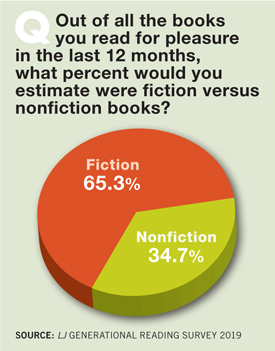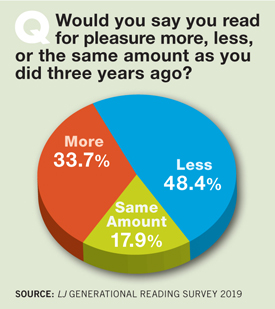Gen-Z Readers: The New Traditionalists | Generational Reading Survey
The next generation of adult (and almost there) readers shows some traditional—and surprising—reading traits.

What comes to mind when you picture a generation of readers that is frugal and thinks there’s nothing like that new book smell?
If you chose Baby Boomers, think again. It’s Generation (Gen) Z, as its members revealed in the second installment of Library Journal’s Generational Reading Survey of consumers who read for pleasure. (For the first installment, on millennials, see “Millennials Are Social Readers | Generational Reading Survey.”)
 Generational definitions are far from an exact science; the start and end dates for Gen Z vary from source to source. LJ aligned those in this report with the Pew Research Center data, meaning those born after 1997, and further restricted the survey to those aged 16 and up.
Generational definitions are far from an exact science; the start and end dates for Gen Z vary from source to source. LJ aligned those in this report with the Pew Research Center data, meaning those born after 1997, and further restricted the survey to those aged 16 and up.
This burgeoning generation of teens and new adults doesn’t remember a life without streaming media. Harry Potter and Percy Jackson loomed large in their childhood. They’ve been the subject of much hand-wringing over the impression that they want nothing to do with anything that isn’t their phone.
A Pew Research Center analysis of U.S. Census Bureau data finds that Gen Z is the most diverse American generation ever. They’re on track to be the most highly educated as well. The oldest members of Gen Z are enrolling in college at a notably higher rate than millennials did at the same age. Their high school dropout rate is much lower, too. Also, they aren’t moving as frequently. In 2018, 11 percent had a different address from the previous year, compared with roughly 17 percent of millennials and 20 percent of Gen Xers. About 40 percent are in the workforce or want to be: 16 percent work part-time, 15 percent work full-time, and nine percent are unemployed and looking for work.
To qualify, respondents had to have read at least one book for pleasure in any format during the previous 12 months. Some 72 percent of respondents passed that screening question—the same as for every generation, so fears that digital natives don’t read have proven unfounded, at least in this survey, contradicting recently released findings from the National Endowment for the Arts’ Survey for Public Participation in the Arts. However, within that 72 percent, 48 percent say they read less now than they did three years ago, 34 percent read more, and 18 percent read the same amount. Only Gen Z readers in urban areas and those with full-time jobs have a higher percentage of respondents who read more books now than they did three years ago.
We set about uncovering Gen Z’s reading, book procurement, and sharing habits; their relationship with libraries; and more. Here’s what they told us.
SOCIALLY DRIVEN
While friend and family recommendations continue to top the list of ways to find new titles, social media is Gen Z’s second choice, at 43 percent, making it the most likely generation to use social media to find out about new books. As to which platform, Instagram was the winner at 59 percent, followed by Facebook at 46 percent (for all older generations, Facebook is number one). Interestingly, these patterns vary by gender; while male response rates were low, those who did weigh in were more likely to use Instagram and Snapchat than women were, and much less likely to use Pinterest.
Which social media sites do you use to learn about books? |
|
| 59.1% | |
| 46.0% | |
| 36.4% | |
| 33.5% | |
| Tumblr | 27.8% |
| Goodreads | 21.0% |
| Snapchat | 16.5% |
SOURCE: LJ GENERATIONAL READING SURVEY 2019 |
|
While YouTube is not strictly considered a social media channel, YouTube influencers collectively ranked as the third most often cited public figure, group, or brand that drives reading choices, after Oprah Winfrey and Michelle Obama. Number four? “My mom.”
Despite—or perhaps because of—this reliance on reading about books on social channels, Gen Z is judicious about posting about books there. A little more than a third of Gen Z readers are “very likely” or “likely” to rate or review that book online or to post their thoughts about it on social media, slightly down from millennial rates.
Do you participate in any book clubs where you read and discuss a preselected book? |
||||||||
| Total Gen Z | Male | Female | White | Non-White | Urban | Suburban | Small town / rural | |
| % of Gen Z in a book club * | 20.8% | 26.8% | 19.7% | 17.1% | 25.1% | 30.6% | 19.8% | 14.2% |
| * either in-person or online book club | ||||||||
|
SOURCE: LJ GENERATIONAL READING SURVEY 2019 |
||||||||
NEED MORE, BETTER MIRRORS
Forty percent of Gen Z reader respondents say it is either “very important” or “important” to them that the books they read reflect their own cultural background, identity, or personal values. And the percentage rises to 44 percent among Gen Z readers of color, 51 percent among urban Gen Z readers, and 53 percent among readers with children. Those for whom it is “somewhat important” accounted for another 28 percent.
 Of those for whom it is important, eight percent report struggling to find such books (11 percent for people of color). While that percentage may seem low, it is double the percentage for the entire sample across all five generations. Comparatively, Gen Z has a much harder time finding books that reflect its myriad identities, probably because of its greater diversity. Of our respondents, 54 percent are white, 17 percent are Black/African American, 13 percent are Hispanic/Latinx, six percent are multiracial, and five percent are Asian. (In the Pew data for the generation as a whole, 52 percent are non-Hispanic white, 25 percent are Latinx, 14 percent are Black/African American, six percent are Asian, and four percent are multiracial.)
Of those for whom it is important, eight percent report struggling to find such books (11 percent for people of color). While that percentage may seem low, it is double the percentage for the entire sample across all five generations. Comparatively, Gen Z has a much harder time finding books that reflect its myriad identities, probably because of its greater diversity. Of our respondents, 54 percent are white, 17 percent are Black/African American, 13 percent are Hispanic/Latinx, six percent are multiracial, and five percent are Asian. (In the Pew data for the generation as a whole, 52 percent are non-Hispanic white, 25 percent are Latinx, 14 percent are Black/African American, six percent are Asian, and four percent are multiracial.)
Gen Z also has the greatest gender diversity, with the highest number of all generations identifying as a nonbinary gender, at 1.2 percent. As one respondent commented when asked about the range of books available, “Genderfluid isn’t represented anywhere!”
Another respondent noted that an increase in overall diversity in books doesn’t help much if the relatively few with diverse narratives don’t happen to be the type that appeal to you, noting, for instance, “There aren’t many books in the kind of genres that I like with relevant Mexican cultural background.” In a similar vein, one participant expressed this frustration: “There are rarely any good books that star a strong, black female lead in love or with badass powers.” Yet another bemoaned that the diverse stories out there are more or less hidden, adding, “Stories about black girls like me aren’t promoted enough—you have to look.”
When it comes to “windows”—books that reflect cultural backgrounds, values, and personal identities different from their own—60 percent of Gen Z readers are interested; though the number is higher for women (63 percent) than men (47 percent).
LIBRARY: SPACE OVER CIRC
Our data revealed that Gen Z readers visit their local branch as often as other generations do, but they’re borrowing fewer books, instead using it primarily as a “third space.” Some 52 percent say they go to read or study, 40 percent because “It’s a comfortable place I’m familiar with,” and 36 percent because “It’s a relaxing place to unwind and spend some ‘me-time.’” Some 62 percent possess a library card, and 59 percent have visited a library in the last 12 months—the same percentage as Baby Boomers. While 36 percent said they got the books they read from the public library, only 22 percent of Gen Z readers borrowed from the library at least monthly in the last year. But that doesn’t mean book goals are off the table: 43 percent say they come because they’re looking for a specific book, and 38 percent want to browse. One fifth of respondents use shelf browsing to find their next read, 18 percent use library displays, seven percent use staff recommendations, and four percent use the library website, newsletter, or online catalog. (Only 28 percent have used the library’s website or app for any reason.) Another 30 percent come for tech resources.

For books that you've read that you did not purchase, where did you get them? |
|
|
Borrowed from friends/relatives |
51.3% |
|
Received as gifts |
42.4% |
|
Public library |
36.1% |
|
Free online reading platforms (e.g., Wattpad) |
27.1% |
|
Other library (e.g., school, college/university, etc.) |
23.7% |
|
Online subscription service (e.g., Kindle Unlimited) |
14.5% |
|
Fan fiction sites |
11.9% |
|
Free book exchange/Little free library in town/neighborhood |
9.0% |
SOURCE: LJ GENERATIONAL READING SURVEY 2019 |
|
If they’re not getting their books from the library, where are they getting them? When respondents buy books, Amazon was chosen by fully two-thirds as their source. However, purchase and library borrowing are far from the only ways in which Gen Z readers acquire their next read. Some 51 percent borrow books from friends/relatives, 42 percent receive them as gifts, and 27 percent use free online reading platforms like Wattpad.
FANTASTIC FICTION
Our Gen Z respondents prefer reading fiction nearly two to one over nonfiction. Their go-to genres differ markedly by gender, though. Women’s four favorite genres are, in order, romance, fantasy and young adult fiction (in a virtual tie), and mystery/suspense. Men, meanwhile, gravitate to fantasy, sci-fi, horror, and mystery/suspense.
Gen Z readers estimate that 65 percent of the books they read are fiction, and 35 percent, nonfiction. Cooking, biographies/memoirs, and history are at the top of their list of preferred nonfiction subjects. Gaming nonfiction is particularly popular with Gen Z men.
What nonfiction subjects do you typically read for pleasure? |
Total Gen Z |
|
Cooking |
29.1% |
|
Biography/Memoir |
28.2% |
|
History |
27.7% |
|
Humor |
26.5% |
|
Health/Fitness/Wellness |
25.4% |
|
Self-Help/Psychology |
25.1% |
|
True Crime |
25.1% |
|
Poetry |
23.3% |
|
Arts (e.g., fine arts, music, theater, etc.) |
21.6% |
|
Science |
20.5% |
|
Pets/Animals |
19.3% |
|
Travel |
18.7% |
|
Crafts/Hobbies |
18.2% |
|
Style/Fashion |
17.3% |
|
Business/Careers |
16.1% |
|
Essays (i.e., personal points of view on select subjects) |
15.9% |
|
Sociology |
14.7% |
|
Gaming |
14.4% |
|
Religion/Spirituality/Philosophy |
13.5% |
|
Home decorating/Gardening |
11.2% |
|
Politics/Current events |
11.0% |
|
Technology |
10.4% |
|
Sports/Recreation |
9.2% |
|
Parenting |
8.6% |
|
SOURCE: LJ GENERATIONAL READING SURVEY 2019 |
|
Of fiction genres, young adult, fantasy, romance, horror, and graphic novels are at least ten percent more popular with Gen Z than they are with the overall sample. Poetry is also at least ten percent more popular with Gen Z than in general, perhaps owing to the rise of social media “Instapoets,” while historical fiction, mystery/suspense, biography/memoir, and history are at least ten percent less popular.
What fiction genres do you typically read for pleasure? |
Total Gen Z |
|
Fantasy |
52.8% |
|
Young adult fiction |
48.7% |
|
Romance |
48.5% |
|
Mystery/Suspense |
48.2% |
|
General adult fiction |
39.5% |
|
Horror |
36.0% |
|
Thrillers |
32.4% |
|
Science fiction |
31.6% |
|
Short stories |
26.5% |
|
Historical fiction |
23.5% |
|
Classic literature |
21.4% |
|
Graphic novels/Manga/Comics |
18.6% |
|
Erotica |
12.2% |
|
Urban lit/Street lit |
8.9% |
|
Christian fiction |
7.7% |
|
SOURCE: LJ GENERATIONAL READING SURVEY 2019 |
|
PRINT STILL PREFERRED
Despite the ongoing narrative of the digital native generations, when it comes to reading long-form content, Gen Z—like millennials—still prefers print books. Hardcover is the most read format (79 percent, compared with 32 percent for ebooks). When they do read digitally, a whopping 77 percent of Gen Z respondents do so on their phone. Some 74 percent read paperbacks and 27 percent prefer them. When asked to name their preferred format, only eight percent said ebooks, compared with 39 percent for hardcovers. If price is not a factor, the preference for hardcovers goes up to 59 percent. The primary reason given for this preference is “the smell and feel of the book,” an explanation chosen at much lower rates by other generations. Some 19.4 percent listen to audiobooks; 7.4 percent prefer them, rising slightly to 7.8 percent if price were not a consideration. Of these, 78 percent get audiobooks from Audible; 38 percent get audiobooks from the library.
What book formats do you typically read or listen to?
|
||
| Book Formats Read by Gen Z |
Gen Z’s Preferred Format* |
|
|
Hardcover books |
79.4% |
38.9% |
|
Paperback books |
73.8% |
27.4% |
|
Ebooks |
31.7% |
8.4% |
|
Audiobooks |
19.4% |
7.4% |
|
No Preference |
17.9% |
|
|
*if read in more than one format |
||
SOURCE: LJ GENERATIONAL READING SURVEY 2019 |
||
COST COUNTS
Perhaps owing to low starting salaries and high student loans, Gen Z is price-driven: when it comes to buying a book, price is the number two consideration at 62.7 percent, second only to the content sample at 67.8 percent. That puts Gen Z’s price sensitivity even higher than that of “Depression babies,” the notoriously frugal members of the Silent Generation. Similarly, when it comes to borrowing from the library rather than purchasing a book, the “book is too expensive to buy” was cited by a majority, 55 percent. Nonetheless, 49 percent say they’ve later purchased a book that they first borrowed from the library, and 76 percent have later purchased books by the same author. On average, respondents purchased 5.3 books in the past year and borrowed 2.7 from the library and another 2.8 from other sources.
GETTING GEN Z RIGHT
As with millennials, relying on the library’s digital presence, tools, and collections to attract and serve Gen Z patrons would be a mistake. While it’s true that the ubiquitous presence of digital channels is baked into their discovery, purchase, and recommendation behavior, the things they value most about the library are essentially core library services at their most traditional: physical spaces and hardcover books. That doesn’t, however, mean that either the spaces or the titles need be old-fashioned; indeed, they should be anything but. Designing welcoming spaces where Gen Z feels equally comfortable coworking and concentrating is key.
Devices Used to Read Ebooks |
|
|
Total Gen Z |
|
|
iPhone or Android phone |
77.1% |
|
iPad or Tablet |
38.2% |
|
Dedicated eReader |
19.1% |
|
Other |
4.6% |
34% read ebooks on more than one type of device. |
|
SOURCE: LJ GENERATIONAL READING SURVEY 2019 |
|
It’s telling that even such a price sensitive generation buys twice as many books as it borrows from the library. And when respondents were asked why, one major answer was that the “library doesn’t have the book,” cited by 29 percent. In urban settings, that number rises to 37 percent! To make sure libraries have the books Gen Z wants in stock, focus on the genres of particular interest to them—not only chart toppers like fantasy, but emerging differentiators like gaming and poetry—and make sure YA and graphic novel resources are shelved where they’re available to adults, not just to teens. Most important, build a diverse collection that reflects this most diverse demographic, and make sure your library displays, policies, and programming are on the same page.
For more on the reading behavior of every adult generation of Americans, look for our full report on all five generations, coming in December.
METHODOLOGY
This study was made possible by the support of sponsors Penguin Random House, Baker & Taylor, bibliotheca, Macmillan, and NoveList. The survey instrument was developed by LJ with input from sponsors.
The survey was hosted by, and respondents were recruited by, an independent market research firm. The full study collected 2,232 responses during May 14-18. The data was tabulated by Library Journal research.
This report is based on 413 Generation Z respondents between the ages of 16 and 22. The data is unweighted.
Christina Vercelletto, former News Editor at School Library Journal, writes for Education Dive, Family Circle, Trip Advisor, and NY Metro Parents.
RELATED
ALREADY A SUBSCRIBER? LOG IN
We are currently offering this content for free. Sign up now to activate your personal profile, where you can save articles for future viewing









Add Comment :-
Comment Policy:
Comment should not be empty !!!